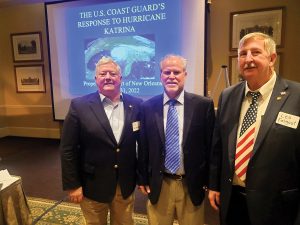Paskewich Recalls Hurricane Katrina Response
The summer of 2022 witnessed the first August without a named tropical storm in many years, and the Propeller Club of New Orleans had unknowingly chosen an ideal time for Capt. (Ret.) Frank Paskewich to review the remarkable response and lessons learned by the U.S. Coast Guard during Hurricane Katrina in 2005.
Speaking at the Metairie Country Club on August 31, Paskewich cited an approval rating from the federal Government Accounting Office that listed the Coast Guard’s response as the major positive action by government agencies in the aftermath of the storm that inundated New Orleans, with 80 percent of the city flooded after multiple levees breached.
The Coast Guard rescued 33,500 people from the flood waters using mostly boats and helicopters.
Now the president of Clean Gulf Associates Inc., an oil spill response company under contract with 77 Gulf of Mexico-based exploration and production clients, Paskewich explained that in 2005 the Coast Guard had just undergone a realignment process, and he was selected as the first captain to head the newly created Sector New Orleans, in addition to his Captain of the Port responsibilities.
The realignment seemed to go well in its first days, and Paskewich held a meeting with the heads of the various groups to compliment them on a seamless transition. He rewarded them with an offer to enjoy the weekend off.
But before the meeting ended, one of his department heads rushed into the room and warned Paskewich that Hurricane Katrina had changed course, and Sector New Orleans’ area of responsibility was now in the crosshairs of the approaching storm, which was packing Category 5 winds offshore.
“All weekend leaves are canceled!” Paskewich told his staff, reversing his directive of a few minutes earlier. Sector New Orleans quickly shifted into response mode.
During the presentation, Paskewich would inject elements of humor as he shared his perspective of the events as they unfolded 17 years ago. Paskewich was only on the job as sector commander 11 days when Hurricane Katrina came ashore as a strong Category 3 on August 29, 2005.
Relying on lessons learned from Hurricane Ivan the year before, Paskewich quickly moved Coast Guard response headquarters to Alexandria, La., a city northwest of New Orleans that’s home to a military base, convention center and air field.Baton Rouge, at half the distance, had been rejected as a relocation site largely because of potential gridlock and insufficient hotel space for the anticipated response influx.
The move would prove highly advantageous as the response teams would grow enormously, soon taking over the entire convention center. The Incident Command Structure (ICS) model was in its infancy then, but Paskewich and his team would build a very efficient structure on the fly. It became a model for future incidents.
Ground Zero
The news on the morning of August 29 was bad: lines broke on ships, which were now floating free in the Mississippi River; levees were breached; a hospital was on fire; oil and hazardous materials spills were reported; and flooding throughout the city forced thousands of residents onto roof tops.
“Then at 11 a.m. we lost comms,“ Paskewich said. “We simply dropped off the grid. There was no communication. I had to get into the air to see what was going on.”Now, only hours after the winds dropped below hurricane force and the storm’s track veered slightly eastward, Paskewich and Marty Bahamonde with the Federal Emergency Management Agency (FEMA) braved the gusts over New Orleans to witness the devastation. A photographer onboard recorded the flooding, shooting through the helicopter’s windows. They saw flooding throughout the city; more flooding and damaged oil storage tanks in Chalmette; the damaged Louisiana Superdome; and the large levee breaches on the 17thStreet Canal and Inner Harbor Navigation Canal.
Jackson Barracks, home of the Louisiana National Guard, was also flooded and evacuated, requiring precious time to regroup and redeploy. He also watched as the Southern Yacht Club at Lake Pontchartrain burned to the ground.
Then he saw the barge aground on the wrong side of the Inner Harbor Navigation Canal levee.
“That one’s on me as captain of the port,” Paskewich thought as he saw the barge that would become emblematic of Hurricane Katrina.
Paskewich was thinking the empty hopper barge had been poorly secured and had penetrated the floodwall, causing massive flooding and destruction in the Lower Ninth Ward.
In reality, the flood waters overtopped the levee, and cascading waters scoured out the ground supporting the poorly-designed levee wall, causing it to fail. Waters flooding through the breach sucked water, and the barge, almost 5 miles down the Industrial Canal. The entire Ninth Ward was flooded to the rooftops.
Paskewich remembers looking with pride as he saw four orange Coast Guard helicopters swooping in to rescue trapped residents from rooftops. As they circled the Superdome and ventured over neighborhoods with hundreds of residents on rooftops needing assistance, the pilot turned to Paskewich and Bahamonde and offered a suggestion.
“We can continue this tour all day, or I can land, put you out, and go save lives,” the pilot said.
Paskewich and Bahamonde got out at the Superdome, where Paskewich said water from the levee breaches was rising 6 inches every hour. On his next two flights, that pilot rescued 13 people.
Paskewich was quick to praise the actions of “junior Coast Guard personnel” who, on their own accord and with assistance from the local law enforcement officers, took charge of a deck barge (ironically numbered 911) and its pushboat to transport civilians from high ground along the Mississippi River at the Chalmette Slip on the east bank to the west bank of the river, where there was no levee breach.
In an operation later coined “Operation Dunkirk,” residents who escaped the flooding downriver from New Orleans would wade miles, first to the relative safety of the levee, and then walk hours to Chalmette Slip, arriving frightened, hungry and exhausted. In all, a total of 7,000 people were transported from the east bank to the safety of the west bank in that operation alone.
“I cannot tell you how awed I was at what those young Coast Guard personnel were able to accomplish,” Paskewich said. “They used their excellent training, recognized a need and used available equipment to save thousands of people.”
Elsewhere, elements of the Coast Guard, local sheriff’s offices, Louisiana Wildlife & Fisheries, state police, FEMA and others deployed a fleet of more than 100 punts from elevated interstates and the few unflooded streets to rescue people from flooded houses and rooftops.Because of risk factors like submerged debris and gunfire from some stranded residents, the urban search and rescue operated daylight hours only from dawn until dusk. Each morning, rescue responders would fan out, knocking on houses and rooftops for a response. Often, they would turn off their outboard engines and listen for faint return knocking sounds of stranded survivors.
The last person was rescued from a flooded home 17 days after Hurricane Katrina passed. He was 80 years old and had lasted all that time in the heat of his home’s attic, yet managed to survive.
Paskewich lauded the great performance of Lt. Cmdr. Shannon Gilreath, who later made admiral, and coordinated “multiple local, state and federal agencies into a cohesive unit under the most difficult conditions.”

Early on, Paskewich recognized the massive rescue operation was having a negative effect on many of the first responders, so each morning he would make the rounds, asking individuals how they were doing, putting a firm hand on shoulders and thanking people for the important work they were doing.
Besides the urban search and rescue effort and overseeing navigation on the Mississippi River, the Coast Guard was also involved in responding to 134 oil spills after Hurricane Katrina, including 10 major oil spills, many in areas accessible only by boat or air. In all, 8 million gallons had spilled, and 42,000 feet of boom were deployed.
Offshore, Paskewich said the Coast Guard’s responsibility, and response, was just as intense, but not as well known.
Fifty-two offshore platforms were damaged, 19 floating drilling rigs were adrift, and he showed a digital slide of topside damage to one of the largest offshore platforms in the Gulf of Mexico, which produced 200 million cubic feet of natural gas and 100,000 barrels of oil daily.
Additionally, six of nine refineries in the sector had shut in.
Conditions on the Mississippi River were also suffering badly. Besides the ships that broke free of their moorings, two coal transfer terminals below New Orleans were badly damaged. Both loaded and empty coal barges from the terminals’ fleets were scattered, with some barges sunk.
The Mississippi River was opened to deep draft traffic on September 12, 15 days after Hurricane Katrina hit. And while it was a pressing requirement from Washington to open the river, most of the facilities near New Orleans and downriver either had no power, major damage or no personnel to operate them.
Upriver was a different story, where the Port of South Louisiana and Port of Greater Baton Rouge suffered less damage and were able to resume operations much more quickly than the Port of New Orleans.
An open river allowed ships from the Maritime Administration to dock in New Orleans to house government officials and responders, which was a huge need. Meanwhile, commercial vessels delivered food and fuel.
“One of the lessons learned was we had to make risk-based decisions and make the call with less than perfect information,” Paskewich said. “Remember, 80 percent of the aids to navigation (ATONs) were destroyed. We had also lost communications early on. Vessels had been tossed around, and some sank. There was no absolute certainty that there were no hidden, unaccounted-for obstructions.”
Concluding his talk, Paskewich also gave praise to the rescue swimmers operating from helicopters, ATON crews and the many Coast Guard personnel who were brought in from around the country. In all, 4,500 Coast Guard personnel responded, which represented 10 per-cent of the entire Coast Guard. “You have to understand, 220 Coast Guard families had significant damage or flooding to their homes, yet they responded when duty called,” Paskewich said.
Before Paskewich left the podium, Cherrie Felder, a long-time industry leader, rose to remind the group that Paskewich’s wife, Leah, voluntarily led the effort to develop a large support group for Coast Guard families who were having to cope with their own family and home disasters, while active-duty family members were working with the massive response. “I watched great people do great things,” Paskewich said. “Semper Paratus!”


